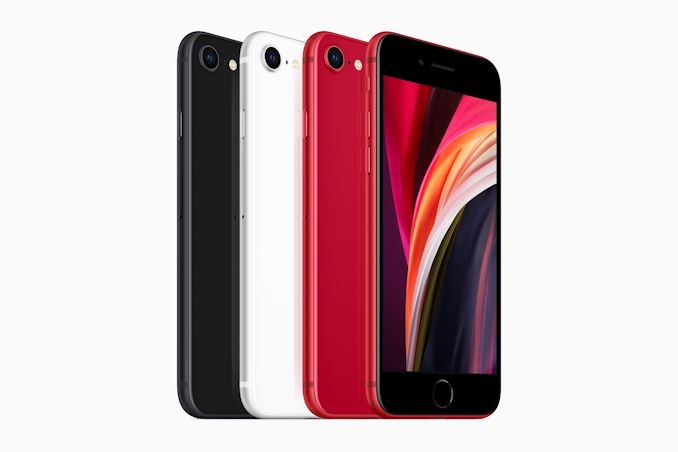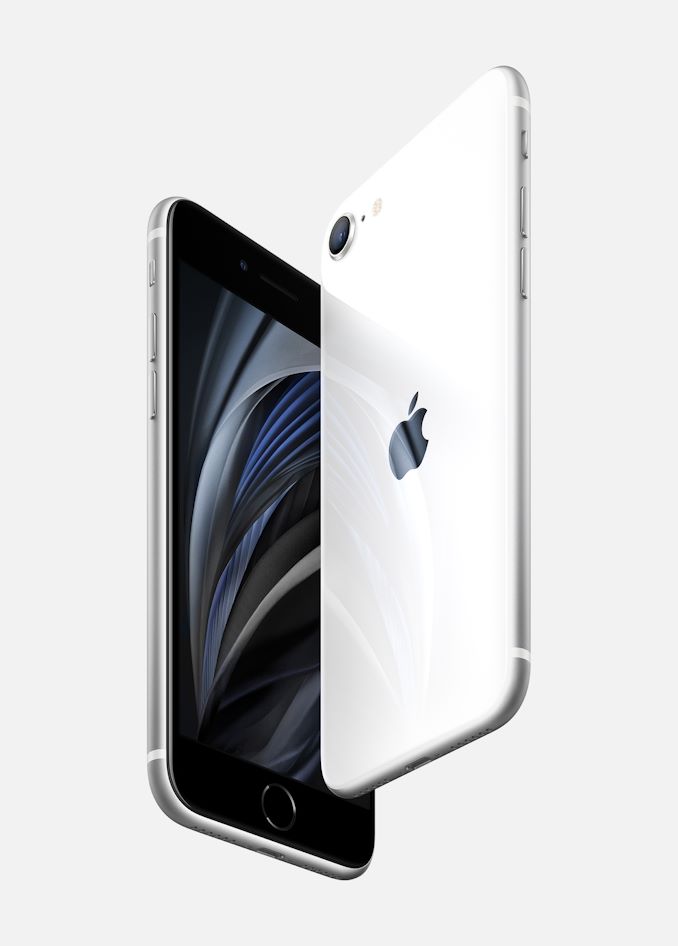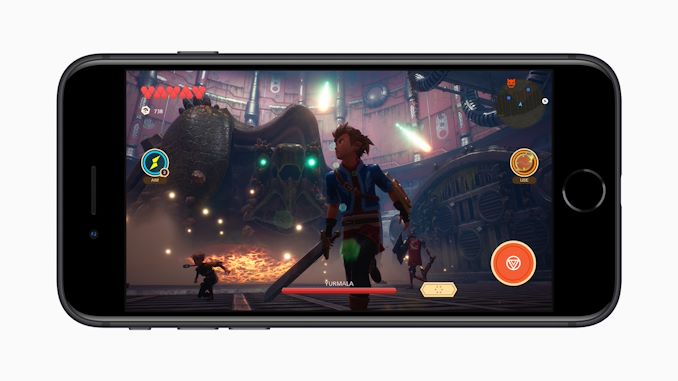Apple Announces New Updated iPhone SE: A13 & New Features for $399
by Andrei Frumusanu on April 15, 2020 1:00 PM EST- Posted in
- Mobile
- Apple
- Smartphones
- iPhone SE 2020

Apple’s last “classic” iPhone release was the iPhone 8 back in 2017, with the 2016 iPhone SE (Special Edition) being the last iteration donning the iPhone 4 design language. It’s safe to say both these devices had been getting a bit long in the tooth, and there’s still plenty of people out there which loved the 4.7” form-factor – and possibly unwilling to update to the newer bigger models.
Luckily, Apple seemingly agrees that this market is worth covering, and today announced a refresh of the 2016 iPhone SE. The new 2020 special edition model takes its design cues from the iPhone 8, essentially taking it as a blueprint for the shell of the phone, and crams in the latest hardware technology that were premiered with the iPhone 11 series.
Most importantly, Apple is offering this new small fierce package at an incredible price point starting at $399, significantly cheaper than even the “lower-end” iPhone 11. The combination seems an outright winner, let’s go over the specifications:
| Apple 2019-2020 iPhone Specifications | |||||
| iPhone 11 Pro | iPhone 11 Pro Max | iPhone 11 |
iPhone SE
|
||
| SoC | Apple A13 Bionic 2 × Lightning Performance @ 2.66GHz 8MB L2 4 × Thunder Efficiency @ 1.73GHz 4MB L2 |
||||
| GPU | Apple, 4 Cores | ||||
| DRAM | 4GB LPDDR4X | ?? | |||
| Display | 5.8-inch OLED 2436×1125 DCI-P3/True Tone 800 cd/m² brightness 2M:1 contrast ratio |
6.5-inch OLED 2688×1242 DCI-P3/True Tone 800 cd/m² brightness 2M:1 contrast ratio |
6.1-inch LCD 1792×828 DCI-P3/True Tone 625 cd/m² brightness 1400:1 contrast ratio - |
4.7-inch LCD 1334×750 DCI-P3/True Tone 625 cd/m² brightness 1400:1 contrast ratio - |
|
| Size | Height | 144.0 mm | 158.0 mm | 150.9 mm | 138.4 mm |
| Width | 71.4 m | 77.8 mm | 75.7 mm | 67.3 mm | |
| Depth | 8.1 mm | 8.1 mm | 8.3 mm | 7.3 mm | |
| Weight | 188 grams | 226 grams | 194 grams | 148 grams | |
| Battery Life | 3046mAh +14.5% capacity "+4H vs XS" |
3969mAh +25% capacity "+5H vs XS Max" |
3110mAh +5.7% capacity "+1H vs XR" |
?? | |
| Wireless Charging | Qi | ||||
| Rear Cameras | Main | 12 MP 1.4µm Dual Pixel PD f/1.8, OIS Wide Color Gamut Quad LED True Tone Flash |
12 MP 1.4µm f/1.8, OIS Wide Color Gamut Quad LED True Tone Flash |
||
| Tele- Photo |
12 MP f/2.0 Telephoto, OIS 2x Optical Zoom |
- | - | ||
| Wide | 12MP f/2.4 120° Ultra-wide Angle |
- | |||
| Front Camera | 12MP f/2.2 Wide Angle | 7MP f/2.2 | |||
| Storage | 64 GB 256 GB 512 GB |
64 GB 256 GB 512 GB |
64 GB 128 GB 256 GB |
64 GB 128 GB 256 GB |
|
| I/O | Apple Lightning | ||||
| Wireless (local) | 802.11ax Wi-Fi with MIMO + Bluetooth 5.0 + NFC | ||||
| Cellular | Gigabit-class LTE-A 4x4 MIMO and LAA |
Gigabit-class LTE-A 2x2 MIMO and LAA |
Gigabit-class LTE-A |
||
| Splash, Water, Dust Resistance | IP68 up to 2 meters (Pro models = 4 meters), up to 30 minutes |
IP67 up to 1 meters, up to 30 minutes |
|||
| Dual-SIM | nano-SIM + eSIM | ||||
| Launch Price | 64 GB: $999 / £1049 / 1149€ 256 GB: $1149 / £1199 / 1319€ 512 GB: $1349 / £1399 / 1549€ |
64 GB: $1099 / £1149 / 1249€ 256 GB: $1249 / £1299 / 1419€ 512 GB: $1449 / £1499 / 1649€ |
64 GB: $699 / £729 / 799€ 128 GB: $749 / £779 / 849€ 256 GB: $849 / £879 / 969€ |
64 GB: $399 / £419 / €479 128 GB: $449 / £469 / €529 256 GB: $549 / £569 / €649 |
|
In terms of hardware, the new 2020 iPhone SE is powered by Apple’s latest A13 chip. Currently this is the most powerful and power efficient mobile chip on the market, and Apple integrating this into the new generation SE probably results in the phone packing quite a punch for its size.
Connectivity wise, it’s also on par with the iPhone 11, featuring “gigabit-class” LTE-A cellular as well as the newest WiFi 6 chipsets for better reception on crowded compatible networks.
We currently don’t have information on the DRAM configuration of the phone, but hopefully Apple doesn’t differ it too wildly from the 4GB standard setup on the iPhone 11 models.
Design-wise, the new iPhone SE should be a very familiar sight to users as it adopts the iPhone 8 design language and frame. This includes a 4.7” 1334 x 750 resolution LCD panel – which in likelihood will be the same as that found on the iPhone 8.
The form-factor nowadays would seem outright diminutive as the phone is smaller in every dimension, coming in at only 138.4 x 67.3 x 7.3mm and weighing in only 148g. If you’ve been looking to get a smaller phone and are in the iPhone ecosystem, the new iPhone SE is the device to get.
On the camera side, the SE only has a single camera – a 12MP sensor with f/1.8 optics and OIS. This isn’t the newer generation sensor found on the iPhone 11 series as it lacks the full-sensor dual-pixel phase detection capability, so it’s likely the unit from the previous XS or iPhone 8 generation. However this doesn’t mean that picture quality will be any less, as Apple promises the phone to perform as the “best single-camera system ever in an iPhone”, and the A13’s new ISP and image processing algorithms will certainly augment the camera to be extremely competitive with what we’ve seen in the iPhone 11 series.
As the phone still features a physical home button, the preferred method of unlocking is Touch ID as the phone lacks the relevant Face ID sensor hardware. Again, iPhone users will be extremely familiar with the setup here as it’ll be essentially the same as what’s found on an iPhone 8.
A Product That Speaks For Itself - Starting At $399
All in all, the iPhone SE is a product that essentially speaks for itself. It’ll be fulfilling the nostalgia needs of users who had been apprehensive to move onto Apple’s newer “iPhone X” design iteration of phones, all whilst updating the internal hardware of the phone in order to not be left out of the generational technology improvements seen by the newest silicon.
It also represents amongst the smallest phones on the market right now – you’d have a very hard time finding similar form-factor smartphones, let alone iPhones.
Apple’s aggressive pricing of starting at $399 for the 64GB base model is going to make this phone a runaway success, even undercutting the iPhone 8 that had been selling for $449 until now (and has now been discontinued). Even the higher storage variants at 128 and 256GB seem outright reasonable at $449 and $549, undercutting the iPhone 11 by $300. European prices start at £419 in the UK and 479€ in continental Europe – a 10% premium on top of the usual VAT margin, so not quite as an aggressive pricing scheme as in the US.
Pre-orders start this Friday, April 17th, with in-store availability next Friday, April 24th.













109 Comments
View All Comments
RSAUser - Wednesday, April 15, 2020 - link
iPhone 8 also doesn't have a headphone jack.Fulljack - Wednesday, April 15, 2020 - link
but iPhone 6s does, which has nearly the same chassis.IBM760XL - Wednesday, April 15, 2020 - link
First spec I checked for in this announcement. I'll stick with my 2016 model SE, which managed to include a headphone jack despite its smaller dimensions.s.yu - Monday, April 20, 2020 - link
Which is why S10e is a genuine alternative.GC2:CS - Wednesday, April 15, 2020 - link
Well well. Would buy three for an 11Pro.But the design is so simmilar, I don’t think there is a bigger XR generation sensor in there. The camera bump on the XR is just way bigger than the one on the 8 and I don’t think they could just cram it in there without changing the bump design.
Also no 3D touch saves a lot of space. Just like SE was great, this should be great too on battery life.
We will see about A13 clock and sustained perf. Deffinitelly a single sided MB on there unlike on the 11. But they report that battery life is unchanged so. We need a review from Anandtech.
And OMG the silver one has a black front. That is the favorite bit for me. If only the back was space gray too. Will need to replace that myself.
kpb321 - Wednesday, April 15, 2020 - link
I don't really get the size comments. The iPhone 8 and this iPhone SE isn't really that much smaller than the iPhone 11 Pro. Yes the regular iPhone 11 and the Pro Max are much bigger but the 11 Pro is only ~4.5mm taller, ~4mm wider ~1mm thicker. I've got an iPhone 8 and iPhone XS sitting on my desk and I have to stack them on top of each other to notice the slight difference in size. Yes the screen is much bigger but that is due to the loss of the home button and the bezels and bot because the phone is significantly larger.SolarBear28 - Wednesday, April 15, 2020 - link
For myself its about reaching the top of the screen with my thumb while holding the phone in one hand. This is much easier to do on old phones with a 16:9 aspect ratio where the top of the screen is closer to the bottom of the phone. On an iPhone you need to do this all the time to click buttons, swipe down, manipulate browser tabs, type in the address bar etc. This is one of the reasons I use an Android where the basic menu buttons are at the bottom, I can install a browser with the address bar and tabs at the bottom, and I use Samsung's One Hand Operation gestures to swipe down from the side, rather than the top of the screen to access shortcuts, notifications, etc.Tomatotech - Wednesday, April 15, 2020 - link
I think you’re talking about Safari. I use Chrome on my iPhone and never need to touch the top bar.Bottom bar has shortcuts for changing tab, slide to change tab, hot button for address bar, hamburger menu etc. No need to reach for top bar.
jeremyshaw - Wednesday, April 15, 2020 - link
You're right. I have an iPhone 6 and the size is practically identical to an iPhone X/11 Pro. If it wasn't for the utterly insane price, I'd probably have considered upgrading from my iPhone 6.Either way, some people are easily misled by big (or small) numbers; let them be happy, eh?
hoodlum90 - Wednesday, April 15, 2020 - link
Too bad the SE camera doesn't have night sight and deep fusion.